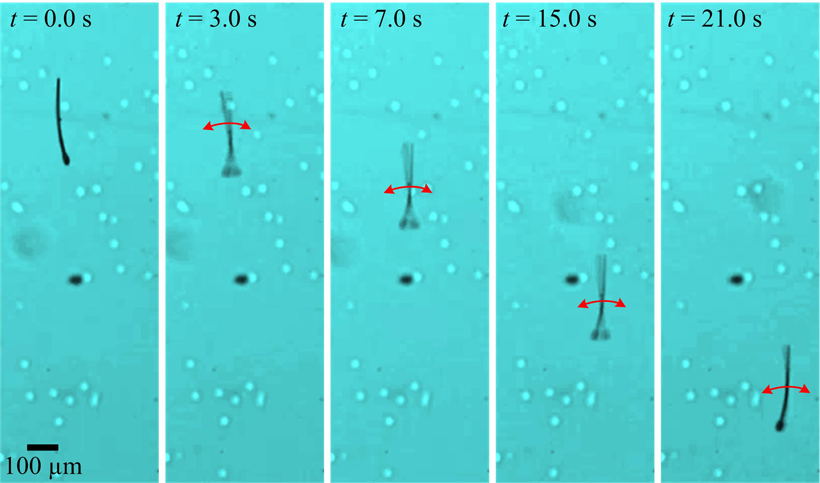Sperm-inspired microrobots controlled by magnetic fields
June 5, 2014

MagnetoSperm performs a flagellated swim using weak oscillating magnetic fields (credit: I.S.M. Khalil/GUC & S. Misra/U.Twente)
A team of researchers at the University of Twente (Netherlands) and German University in Cairo has developed sperm-inspired microrobots that can be controlled by weak oscillating magnetic fields.
Described in a cover article in AIP Publishing’s journal Applied Physics Letters, the 322 micron-long robots consist of a head coated in a thick cobalt-nickel layer and an uncoated tail.
When the microrobot is subjected to an oscillating field of less than five millitesla — about the strength of a decorative refrigerator magnet — it experiences a magnetic torque on its head, which causes its flagellum to oscillate and propel it forward.
The researchers are then able to steer the robot by directing the magnetic field lines towards a reference point. The propulsion mechanism allows for swimming at an average speed of about 158 microns/second with a weak 45 Hz magnetic field.
Islam Khalil, PhD, an Assistant Professor of the German University in Cairo, designed the MagnetoSperm microrobots along with Sarthak Misra, PhD, and colleagues at MIRA-Institute for Biomedical Technology and Technical Medicine at the University of Twente.
“Nature has designed efficient tools for locomotion at micro-scales. Our microrobots are either inspired from nature or directly use living micro-organisms such as magnetotactic bacteria and sperm cells for complex micro-manipulation and targeted therapy tasks,” said Misra, the principal investigator of this study, and an associate professor at the University of Twente.
The ‘robotic’ sperm that could change…
Assembling nano/microscale objects
“As technology progresses and many products get smaller, it becomes difficult to assemble objects on nano- and micro-scales,” Dr. Islam Khalil, an assistant professor of the German University in Cairo, said.
“MagnetoSperm can be used to manipulate and assemble objects at these scales using an external source of magnetic field to control its motion.”
The microrobot was made by spin-coating onto a silicon support wafer a five-micron layer of SU-8, a polymer chosen for its ease of fabrication and mechanical stability. The cobalt-nickel layer was then added to the head by use of electron beam evaporation.
Future plans
In the future, the researchers hope to further scale down the size of MagnetoSperm. The team is currently working on a method to generate a magnetic nanofiber that can be used as a flagellum.
“MagnetoSperm has the potential to be used in diverse biomedical applications such as targeted drug delivery, in vitro fertilization, cell sorting, and cleaning of clogged arteries, but currently, we are planning on using MagnetoSperm to achieve complex micro-assembly and micro-manipulation tasks,” Khalil told KurzweilAI in an email interview.
“A few other researchers have also introduced microrobots that are inspired by nature. However, our robot has these advantages: it is easy to fabricate, can be easily scaled down, and the locomotion depends on oscillating weak magnetic fields that can be easily provided.
“We are working on manufacturing MagnetoSperm from a biodegradable material and also fabricating the head of MagnetoSperm using drugs using an electro-spinning process. This will allow MagnetoSperm to be used in targeted therapy. However, the microrobot still requires in vitro and in vivo experiments to characterize its properties and optimize its parameters.”
KurzweilAI previously reported on two other sperm-inspired projects. “The key difference with MagnetoSperm is that it’s a micro-sized object that is fabricated in the cleanroom,” Misra explained to KurzweilAI. “By the application of weak magnetic fields we propel the MagnetoSperm. We can mass produce these objects in various optimized sizes. So the MagnetoSperm can be oriented to move precisely in a certain direction for potential targeted drug delivery applications.
“In the work of Taher Saif, they have cells attached to the tail structure and appears to be of mm-scale; Magdanz et al. have a microtube containing a real sperm cell.”
Abstract of Applied Physics Letters paper
In this work, a propulsion system similar in motion to a sperm-cell is investigated. This system consists of a structure resembling a sperm-cell with a magnetic head and a flexible tail of 42 μm and 280 μm in length, respectively. The thickness, length, and width of this structure are 5.2 μm, 322 μm, and 42 μm, respectively. The magnetic head includes a 200 nm-thick cobalt-nickel layer. The cobalt-nickel layer provides a dipole moment and allows the flexible structure to align along oscillating weak (less than 5 mT) magnetic field lines, and hence generates a propulsion thrust force that overcomes the drag force. The frequency response of this system shows that the propulsion mechanism allows for swimming at an average speed of 158 ± 32 μm/s at alternating weak magnetic field of 45 Hz. In addition, we experimentally demonstrate controlled steering of the flexible structure towards reference positions.